After a slow start to the season, Real Madrid have begun to turn a corner as they came into this game undefeated from the previous three encounters, which also included the 3-1 victory in El Clásico. Inter, on the other hand, had a forgetful October as Antonio Conte’s men failed to register a single win during the last month.
Group B has so far proved to be one of the most fascinating groups of this year’s UEFA Champions League as the underdogs Shakhtar Donetsk sit in the top half of the table along with Borussia Mönchengladbach while the likes of Real Madrid and Inter languish in the bottom half.
The latter two teams were pitted against each other during the third game week of the campaign as this tactical analysis report aims to showcase the tactics that were used by both the managers in what was supposed to be a crucial battle for both the teams in terms of their survival in the tournament.
Lineups
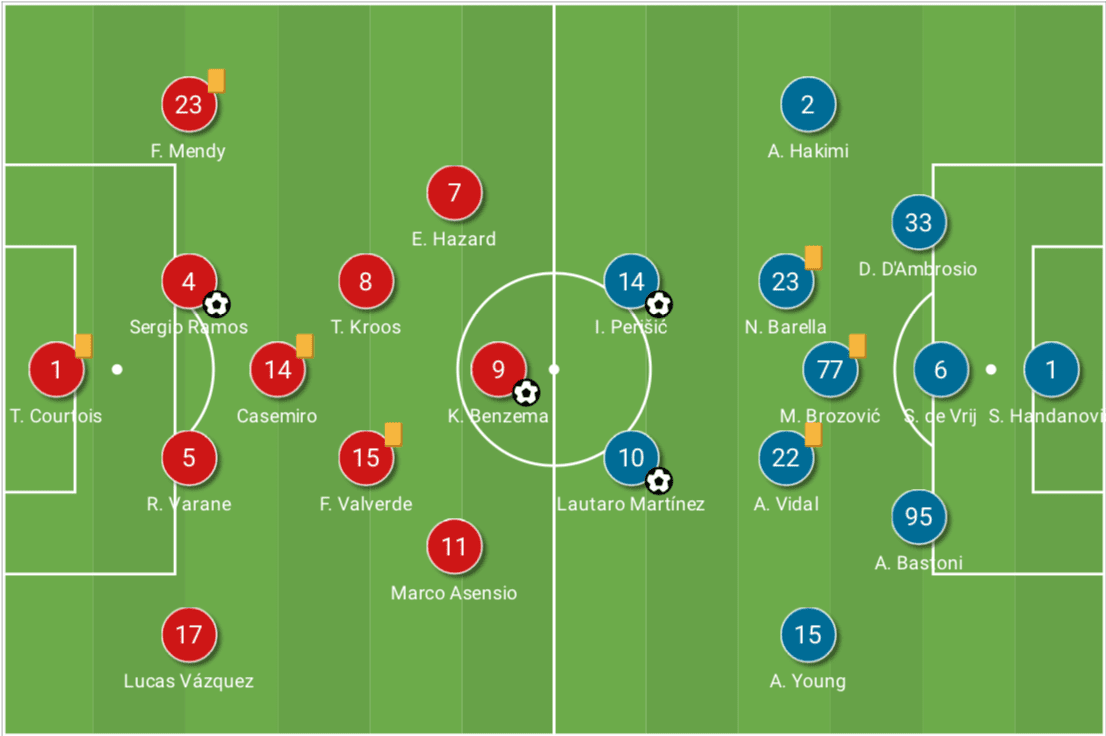
Zinedine Zidane started with his preferred 4-3-3 system and made three personnel changes from his side’s 4-1 victory against Huesca over the weekend. Ferland Mendy came in for Marcelo, Raphaël Varane replaced Éder Militão, and Toni Kroos in place of Luka Modrić as the trio, who played in their previous Champions League game against Mönchengladbach, returned to the team after getting rest over the weekend. Eden Hazard started for the first time in this year’s UCL campaign.
Conte, on the other side, had also rested his key players over the weekend in their 2-2 draw against Parma. Hence, the Italian manager made wholesome changes for this game which included the return of Danilo D’Ambrosio and Alessandro Bastoni for Andrea Ranocchia and Aleksandar Kolarov respectively, Ashley Young for Matteo Darmian, Marcelo Brozović for Roberto Gagliardini, and Arturo Vidal for Christian Eriksen.
Inter’s buildup
Inter’s buildup and attacking play patterns in this game were no different than what we have seen under Conte since he took over as their manager. I Nerazzurri is a possession-based team that has kept 59.2% of the possession in Serie A so far, which is the league-highest. Naturally, they tend to play out from the back. The following figure shows the buildup shape of the visitors during this game.

Stefan de Vrij generally got out of his defensive line to push slightly high alongside Brozović as the remaining two centre-backs split wide during the goal-kick. While Young and Ashraf Hakimi were responsible to provide width in their attack, Vidal floated within the deeper areas to adjust the spaces. If de Vrij stayed deeper into the defensive line, Vidal would drop deep and stay central alongside Brozović. Alternatively, the ex-Barcelona midfielder would also become a left-back in order to allow Young to push even higher. On the other side, D’Ambrosio often pushed wider to occupy the right-back position which provided Hakimi the license to push forward. The latter scenario is displayed in the following image.

Brozović and Bastoni were key players in progressing the ball from the deeper areas for Inter as they excel in this role. They made nine progressive passes combined, seven of which were in the final third. Moreover, Brozović’s 76 passes and Bastoni’s 62 passes were the highest amongst their other teammates. Samir Handanović looked for one of these players often as a first pass during the first phase. The following short passing map of the goalkeeper clearly indicates his propensity to go towards either of these players.
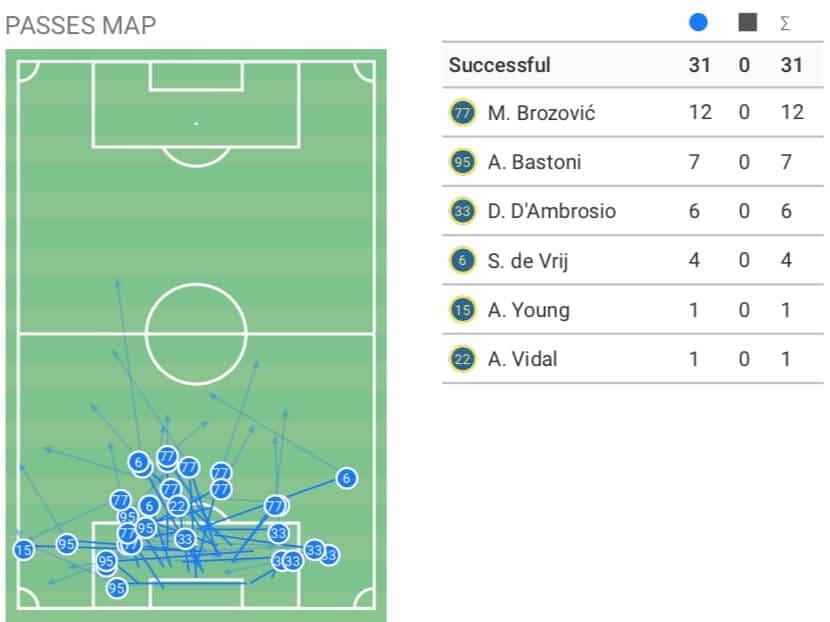
The above graph also indicates that Handanović was especially reliant on Brozović during the buildup. The 36-year old often looked for the Croatian even when there were other safer options available, which is illustrated by the following scenario.
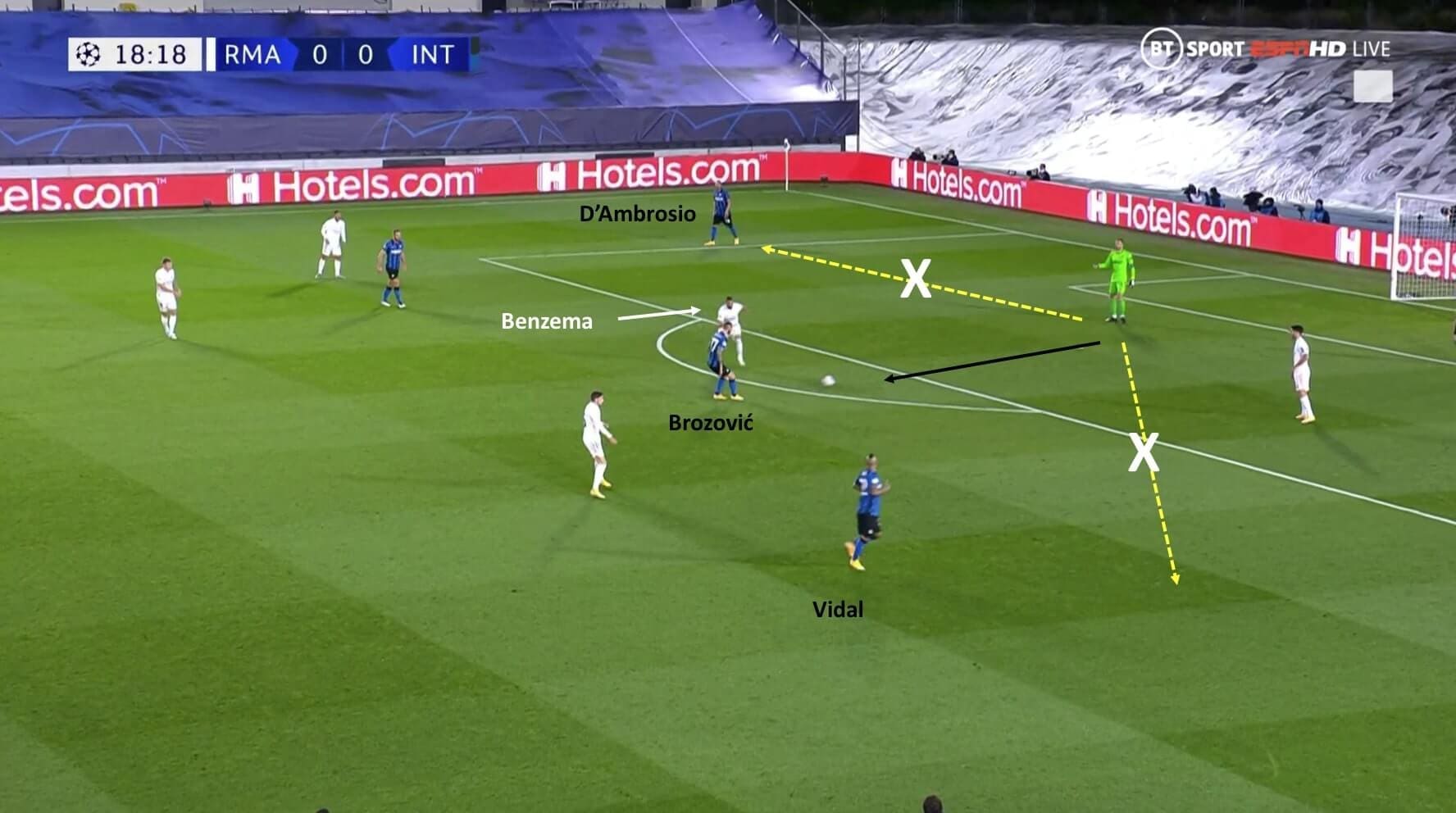
D’Ambrosio on his right and Vidal on his left were clearly safer passing options. However, Handanović passed the ball to Brozović in the center, who was being closed in by Karim Benzema.
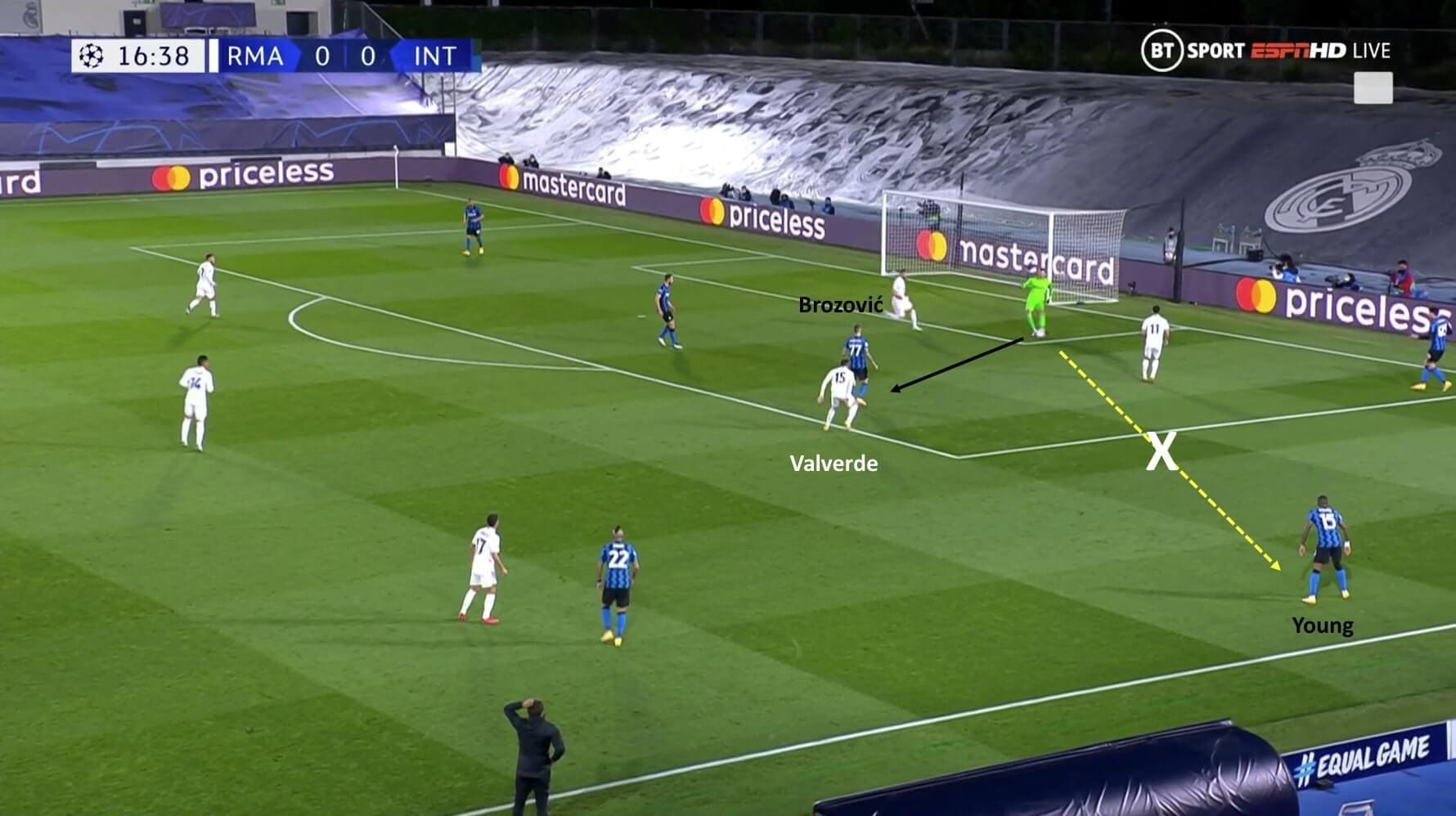
In the above snapshot, Young was free and a pass to the ex-Manchester United player would have overloaded the left flank along with Vidal. A pass to Brozović was a dangerous option as he was very tightly marked by Federico Valverde. Despite that, the goalkeeper insisted on playing the ball to the Croatian.
Real Madrid’s high press
Zidane employed a man-oriented high-pressing system against Inter’s buildup play in which the players were assigned specific markers and were instructed to follow the markers along the field tightly. The initial man-marked pressing shape is shown in the figure below.
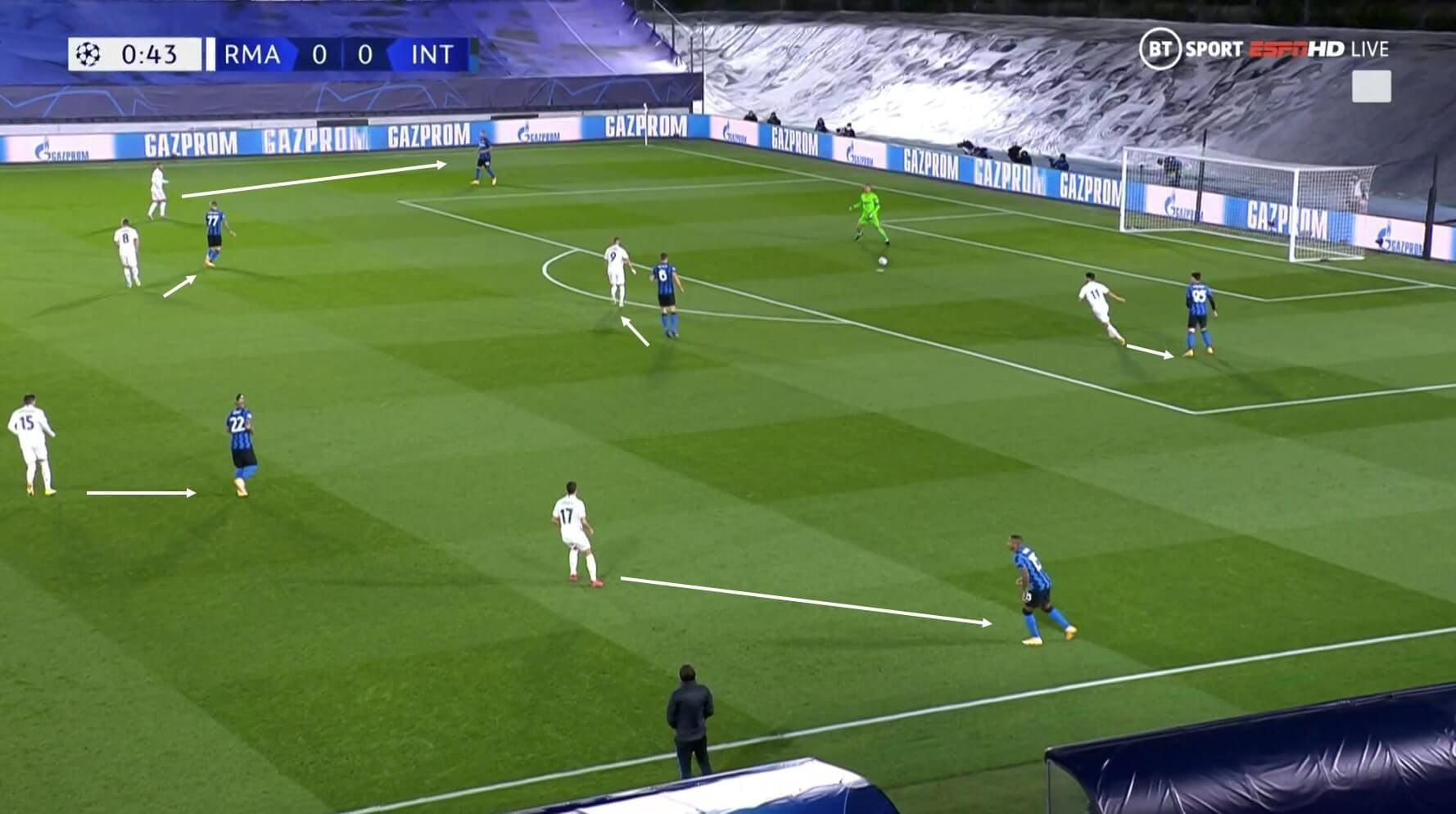
As Handanović looked for the options ahead of him, Madrid’s front-three was closely tracking the Inter back-three. Ahead of them, the central-midfield trio marked their counter-parts as Valverde and Kroos man-marked Vidal and Brozović respectively while Casemiro stayed tight to Nicolò Barella (not in the image). On the flanks, the Madrid full-backs stayed closer to the Inter wing-backs as Lucas Vázquez can be seen tracking Young in the image above. Finally, Zidane laid his confidence in Sergio Ramos and Varane and instructed them to man-mark Ivan Perišić and Lautaro Martínez respectively. The following graphic shows represent a clear image of Madrid’s pressing plan.
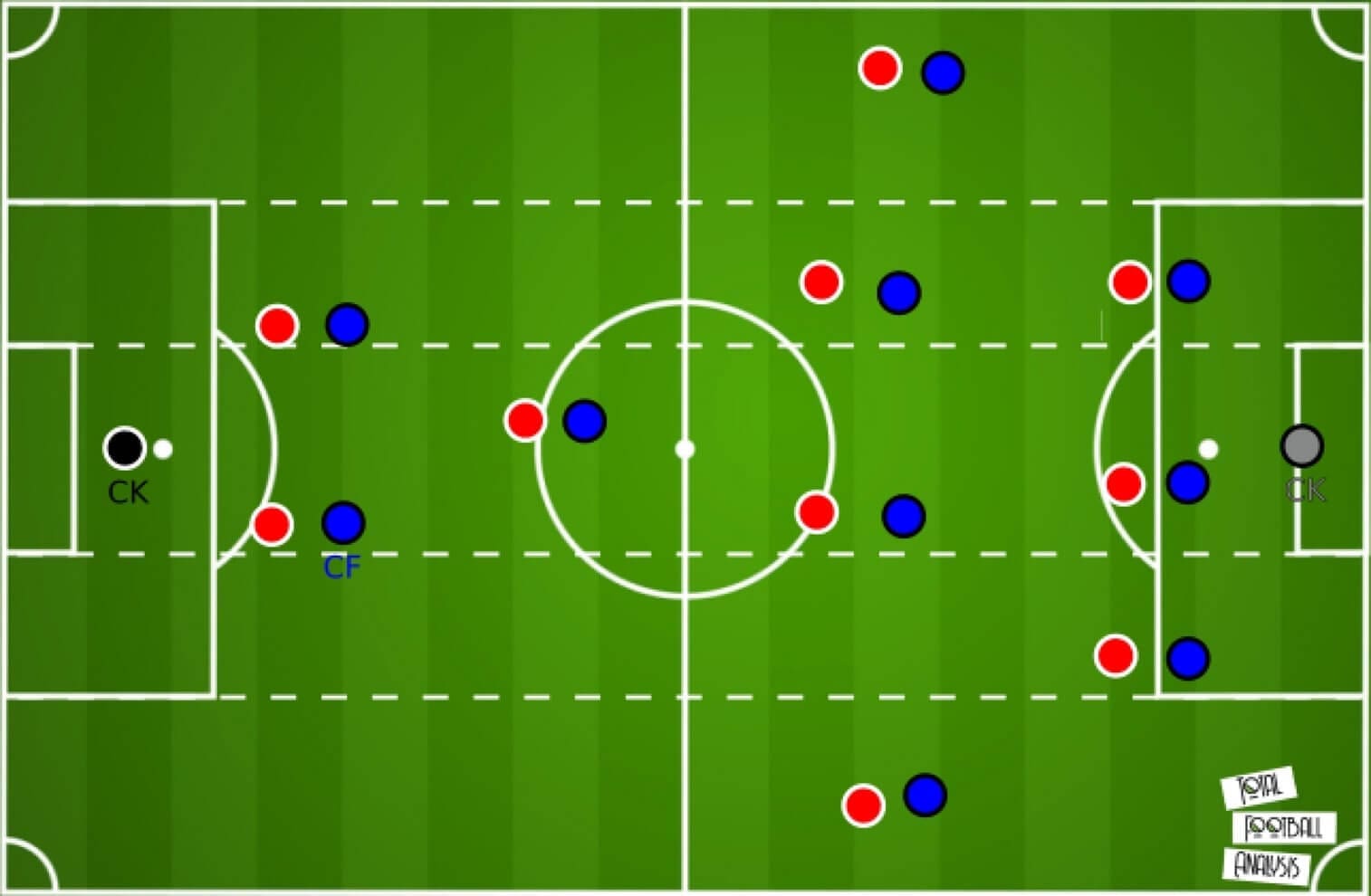
Such kind of a high-pressing man-to-man structure compelled Madrid to commit several men forward as Inter built with 6-8 players in their own half. This ploy from the French manager was a high-risk high-reward one. The Madrid defenders could potentially become isolated and underloaded in their own third if Inter could make vertical progression by breaking the front press. However, proper execution of the plan meant that the Inter players would find it difficult to penetrate the Madrid defence. Indeed, Zidane’s men were effective in their tactics earlier in the game as the tight marking forced the Inter players to receive possession facing their own goal more often which naturally made ball progression difficult.
However, after going 2-0 up, Zidane’s men put their legs off the pedal as their intensity in the front press reduced, as shown in the following PPDA graph.
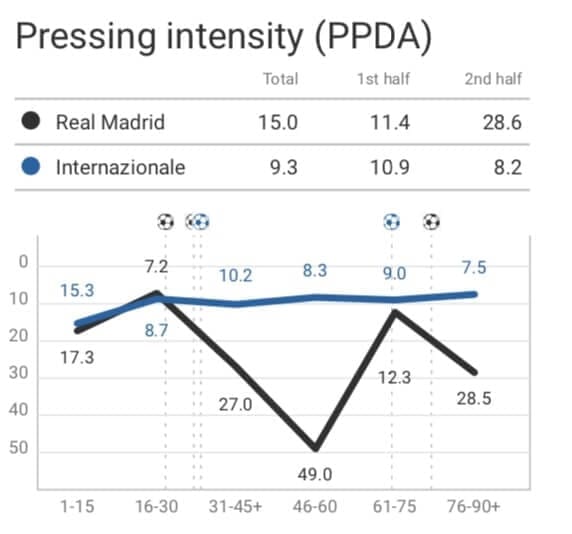
It opened few gates for Inter’s attacks as we shall see in the next section.
How did Inter build their attacks through the high-press?
While there are several ways to break the kind of a man-marking system that Madrid had employed, Inter primarily utilized the third-man runs by creating and exposing spaces between the Madrid’s lines after drawing them for the press. The short-passing map of Handanović that was shown earlier indicated that Inter built from very deep areas. In fact, most of the passes were within the 20-yard circle. Hence, the high-press of Madrid stretched their lines vertically which consequently created ample spaces between their lines.
One of Inter’s forwards (majorly Martínez) would then drop into space and hold the ball before laying off directly to a marauding wing-back or laying it off to a central midfielder who would attempt to find a wing-back while facing the goal. The following figure shows an instance of the tactic.
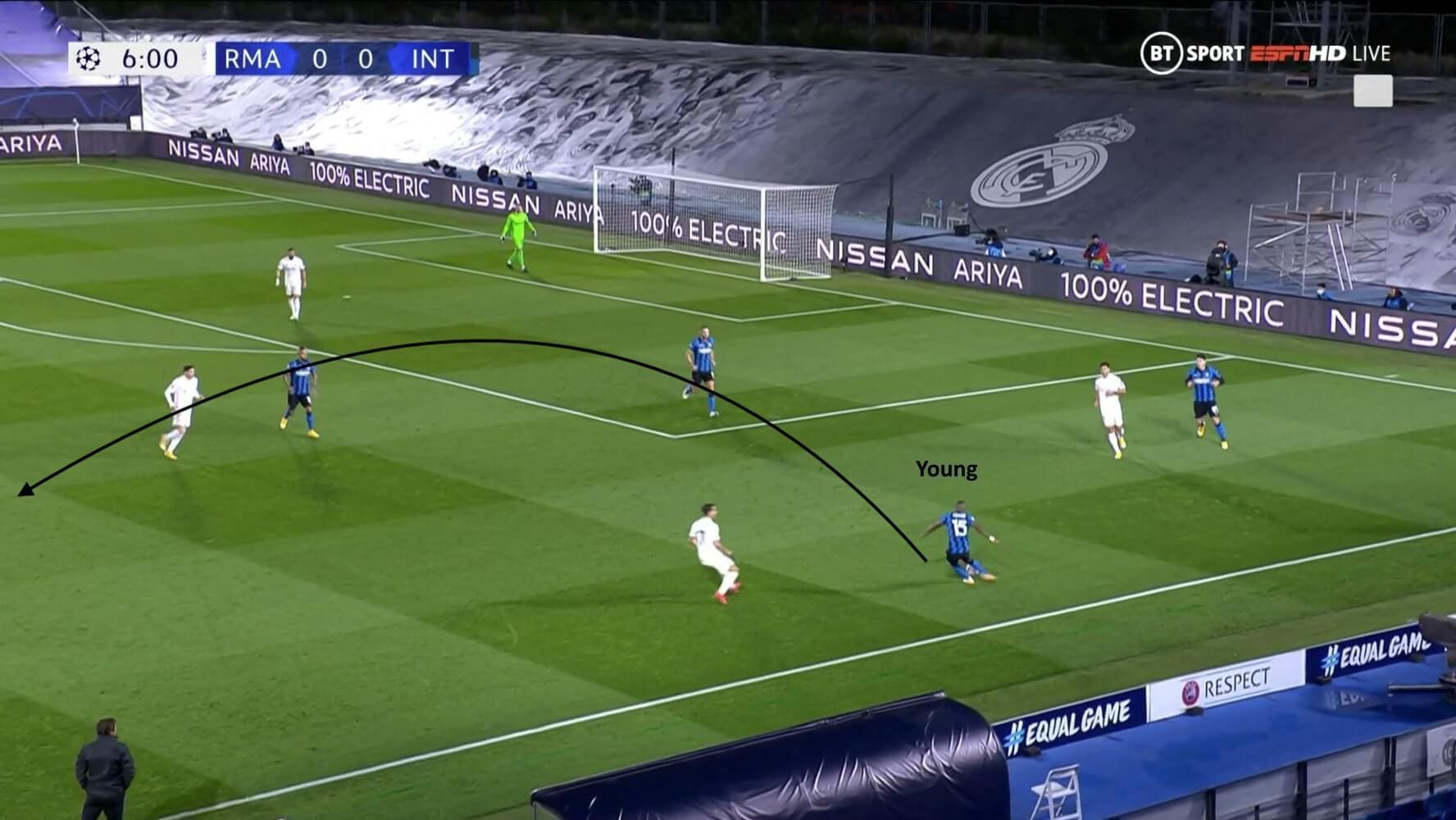
As Young received possession in his own half, he was followed by Vázquez as the front two lines of Madrid had committed forward for the front press. Instead of making a risky turn, the 35-year old, while facing his own goal, lay a long ball into the space between the lines for Martínez, who dropped deep in order to receive the possession, which is shown in the following figure.
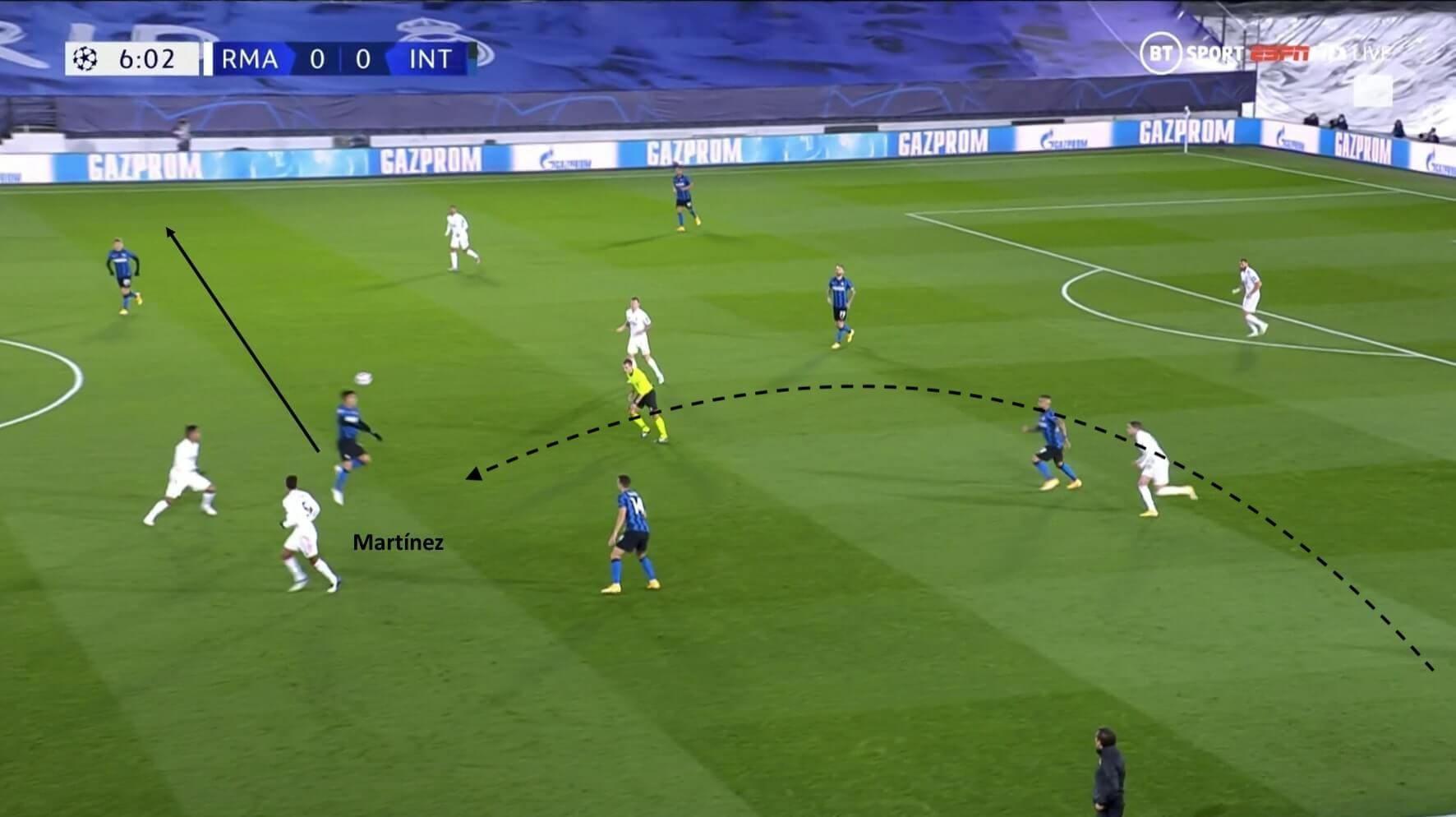
As soon as the striker had the ball in control, he looked to lay the ball off towards his left where Hakimi (not in the image) had already pushed higher. An accurate pass would have opened up the Madrid defence. Unfortunately, the pass was intercepted which halted the Inter attack.
Although Conte’s side created opportunities where they were able to isolate the Madrid defence using this tactic, they were mostly sloppy in taking their chances in the final third, just like the previous image. Most of those chances came from the right as Inter attacked 49% from that side. Hakimi being the more attacking full-back than Young reasons the thinking. Having said that, they missed their best ball-holding striker Romelu Lukaku in the centre, who could have proved more effective in their third-man run tactic.
Madrid’s high press started to wore off as the game progressed which allowed Inter to make use of the progressive runs from the deeper areas to create spaces in the higher areas. Once again, Brozović and Bastoni played a significant role as they received maximum possession during the buildup, as established earlier. An instance is shown in the following figure.

Kroos was slow to press Brozović this time which allowed the midfielder to receive the ball from Handanović and make a turn on his right to evade the press.
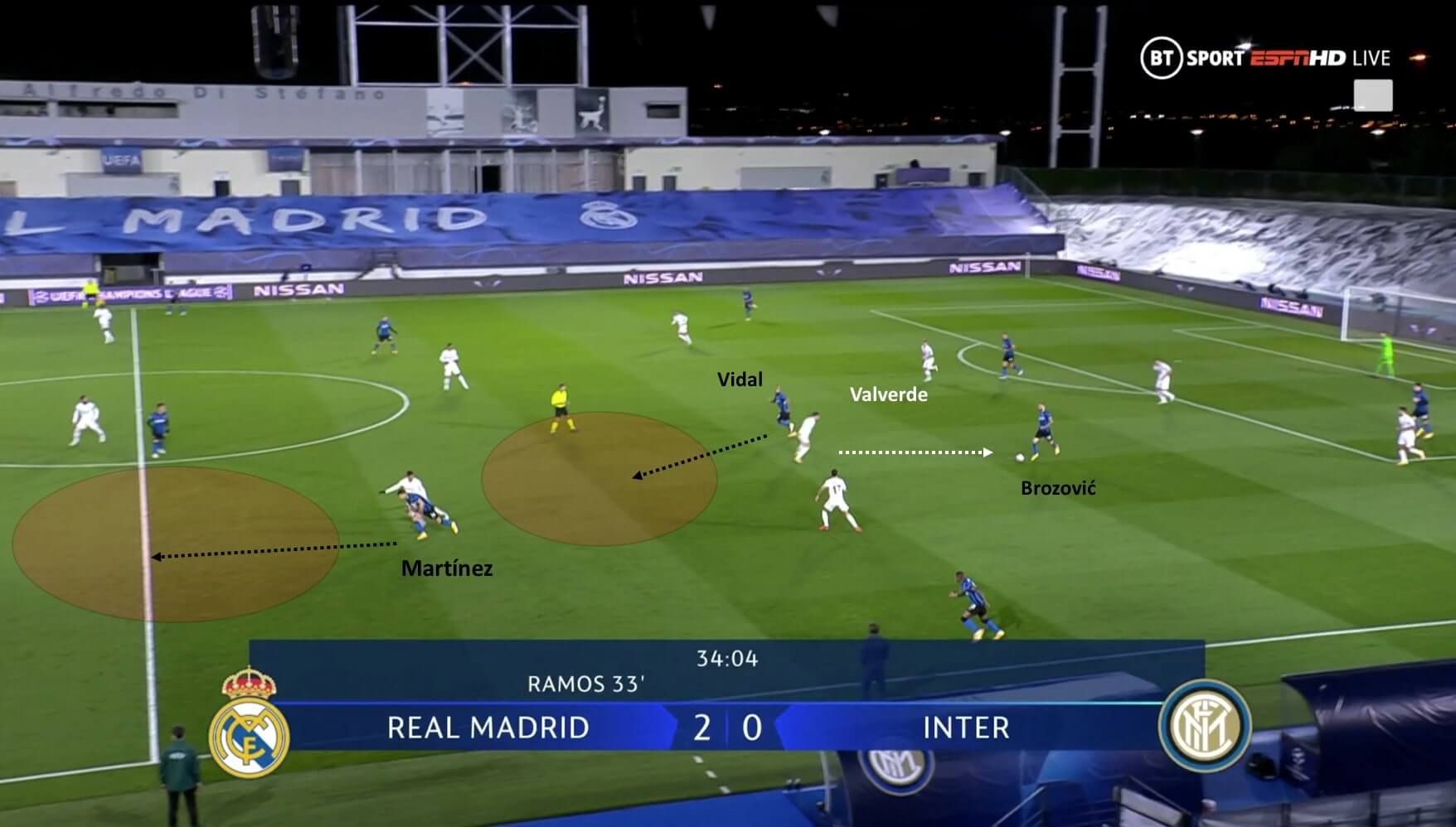
As the Croatian found himself in the space, he attracted Valverde to leave Vidal, in turn, creating a passing option to the Chilean who would then have space in front of him. Besides, Brozović had a long ball option towards Martínez as the Argentine had already started his run beyond his marker. Once again, Inter were lacklustre as Brozović’s pass to Vidal was too slow which forced the Chilean to withdraw the attack.
At times when Inter retained possession comfortably in their own third and Madrid couldn’t employ the high press, I Nerazzurri formed their attacks in a 2-3-1-4 shape where the wing-backs were instructed to bombard forward in order to provide width in the final third of the pitch. Besides, it would stretch the opposition defence and invite the full-backs towards them.
This kind of shape handed a key tactical advantage to the visitors as it isolated the Madrid centre-backs two-versus-three against the Inter forwards along with Barella who stayed behind the front-four to overload the zone 14 and inject creativity from the centre. This aspect played a major role in the visitor’s first goal which is shown below.
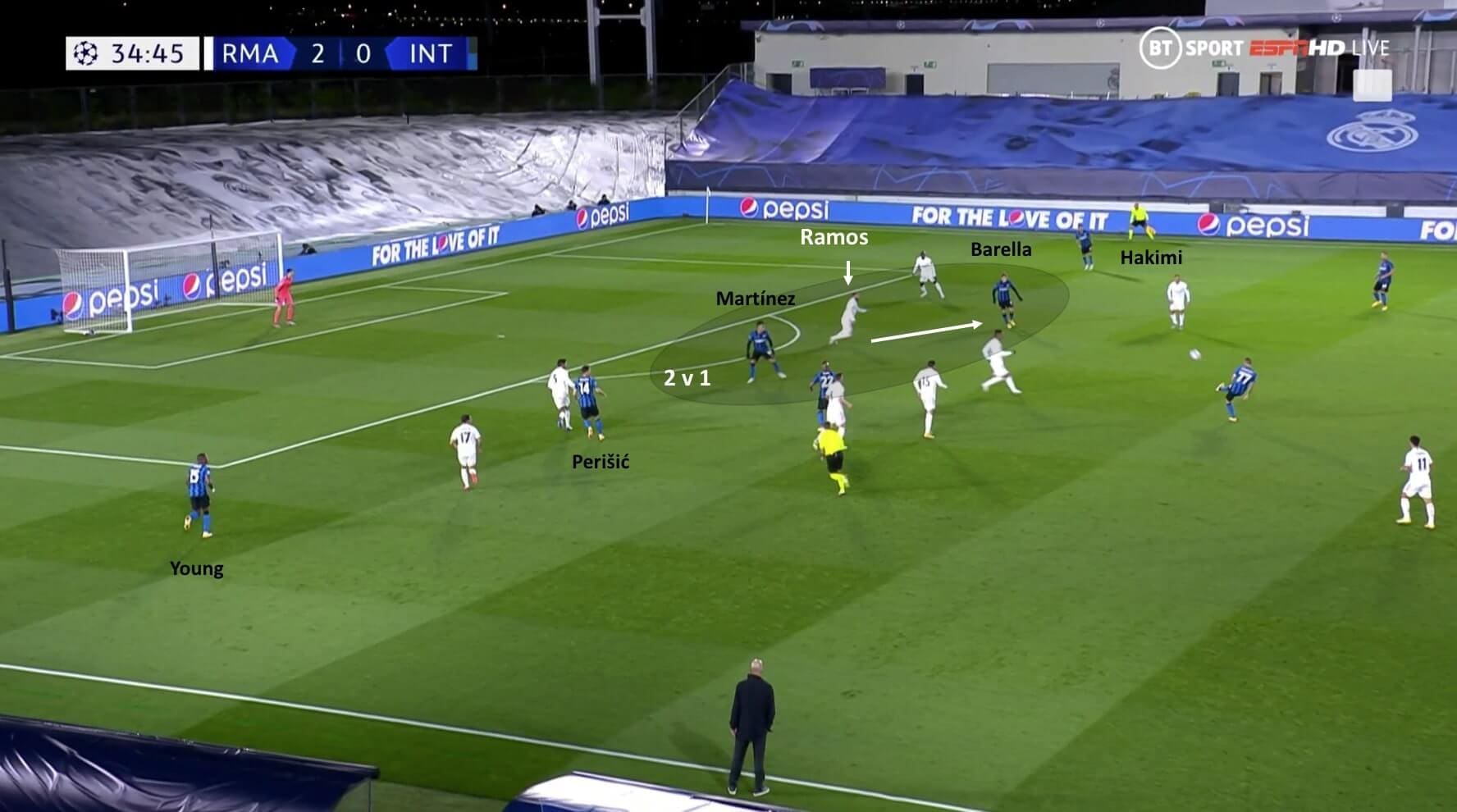
Observe that Hakimi’s movement had drawn Mendy away from Ramos. Hence, the Spaniard was isolated two-versus-one against Barella and Martínez which forced him to draw out of his marker and close down Barella. However, the youngster’s marvellous one-time back flick sent Martínez clear in front of the goal who did not slot a first-time finish.
Madrid, on the other hand, organized themselves into a mid-block 4-1-4-1 shape when they were out of possession. The shape was horizontally and vertically compact, as shown in the figure below.
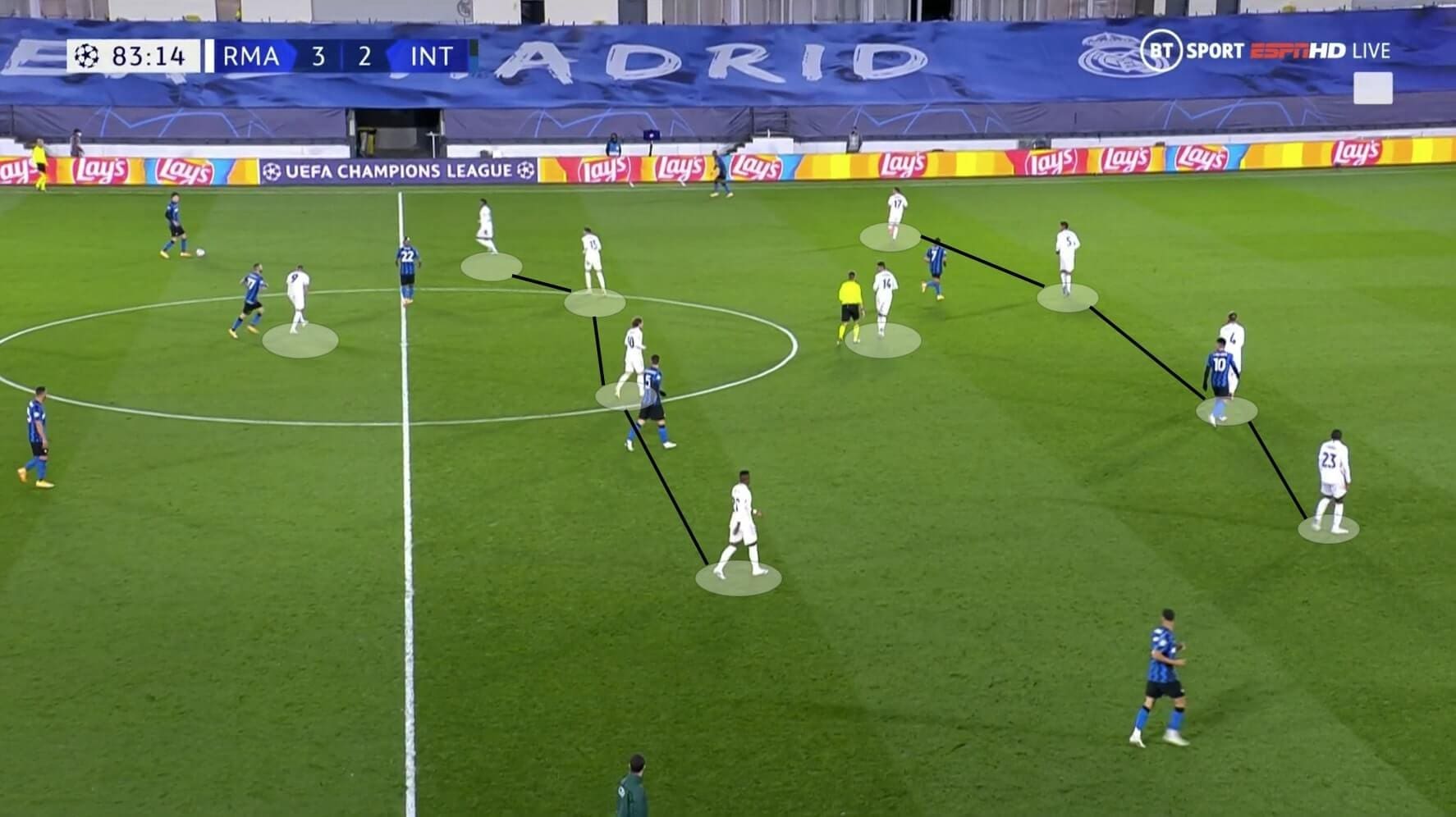
Inter’s high press and Madrid’s quick switch of play
Similar to the other end of the pitch, Madrid’s third also demonstrated a high pressing system from Inter and Madrid’s propensity to build out from the back. Having said that, there were tactical differences in each of those aspects, as we shall see in this section.
Akin to Los Blancos, Inter also pressed high up the pitch to deny the opponent to build swiftly from the back. However, the visitors employed a space-oriented man-marking system, which is a mixture of zonal and man-marking. Each player has a space to cover and marks the opposition player who gets into space rather than following a specific player, as Madrid did.
The two forwards occupied Madrid’s central defenders, Brozović pushed high to press Madrid’s holding midfielder Casemiro. Besides, Barella dropped deep alongside Vidal to mark Madrid’s two central midfielders. Finally, the ball-sided wing-back pushed high to press the full-back while the ball-far wing-back stayed back to ensure a four versus three numerical superiority in the defence. The representation is shown in the following figure.
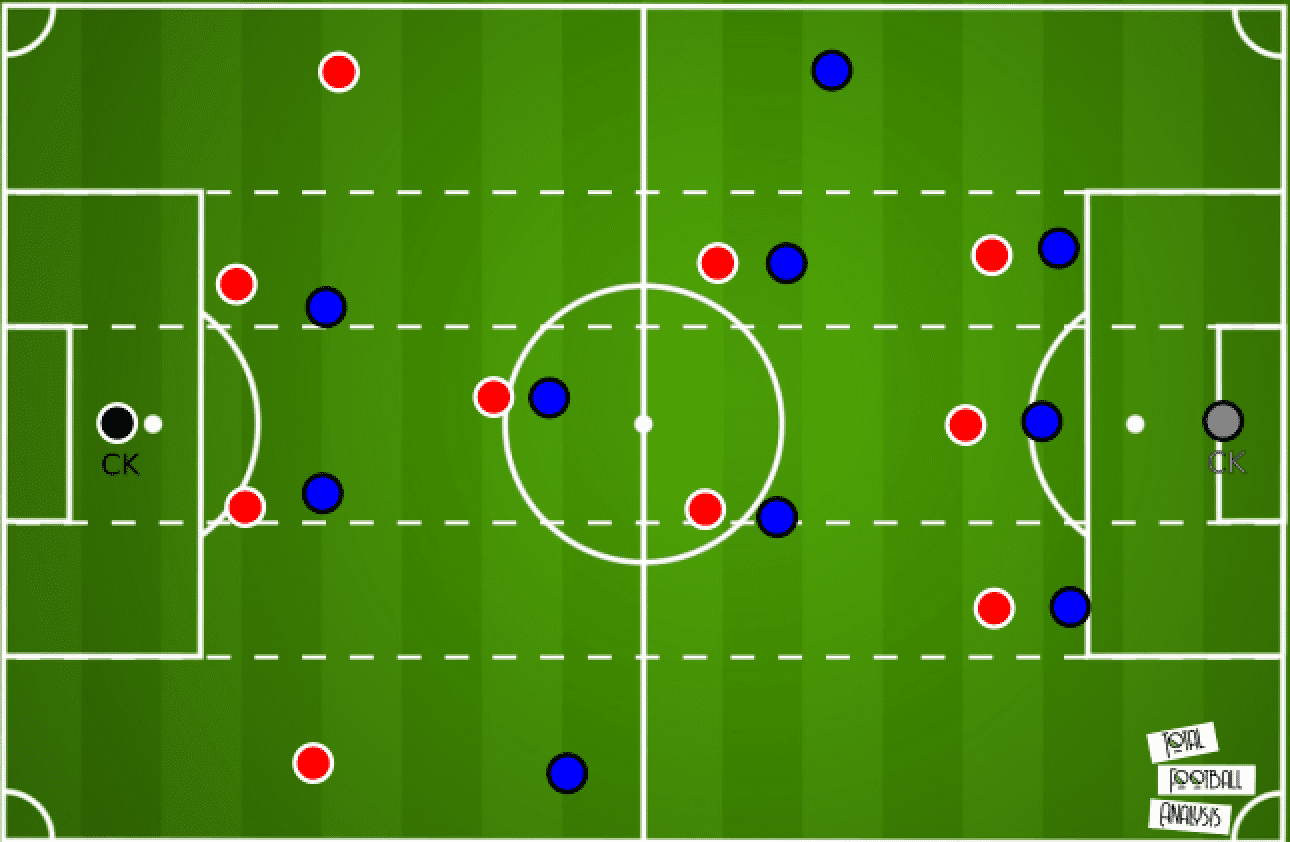
Madrid, like Inter, also started their buildup from the areas deeper than the 20-yard circle. While the centre-backs split inside the penalty box, the full-backs spread across the flanks while holding deeper positions. Thibaut Courtois’s initial pass to one of the centre-backs was followed by a lay off to the ball-sided full-back, who would be closer to a corner point. As Inter players would be invited to press towards one side and cause an overload, it would create spaces on the other side of the field. Consequently, Madrid would then look to switch the play quickly to isolate the Inter players and ensure effective vertical progression.
Madrid used this tactic across all the thirds, as they looked to create spaces and overloads in key areas. The following figure showcases the usage of the tactic in the defensive third to progress the ball into the middle third.
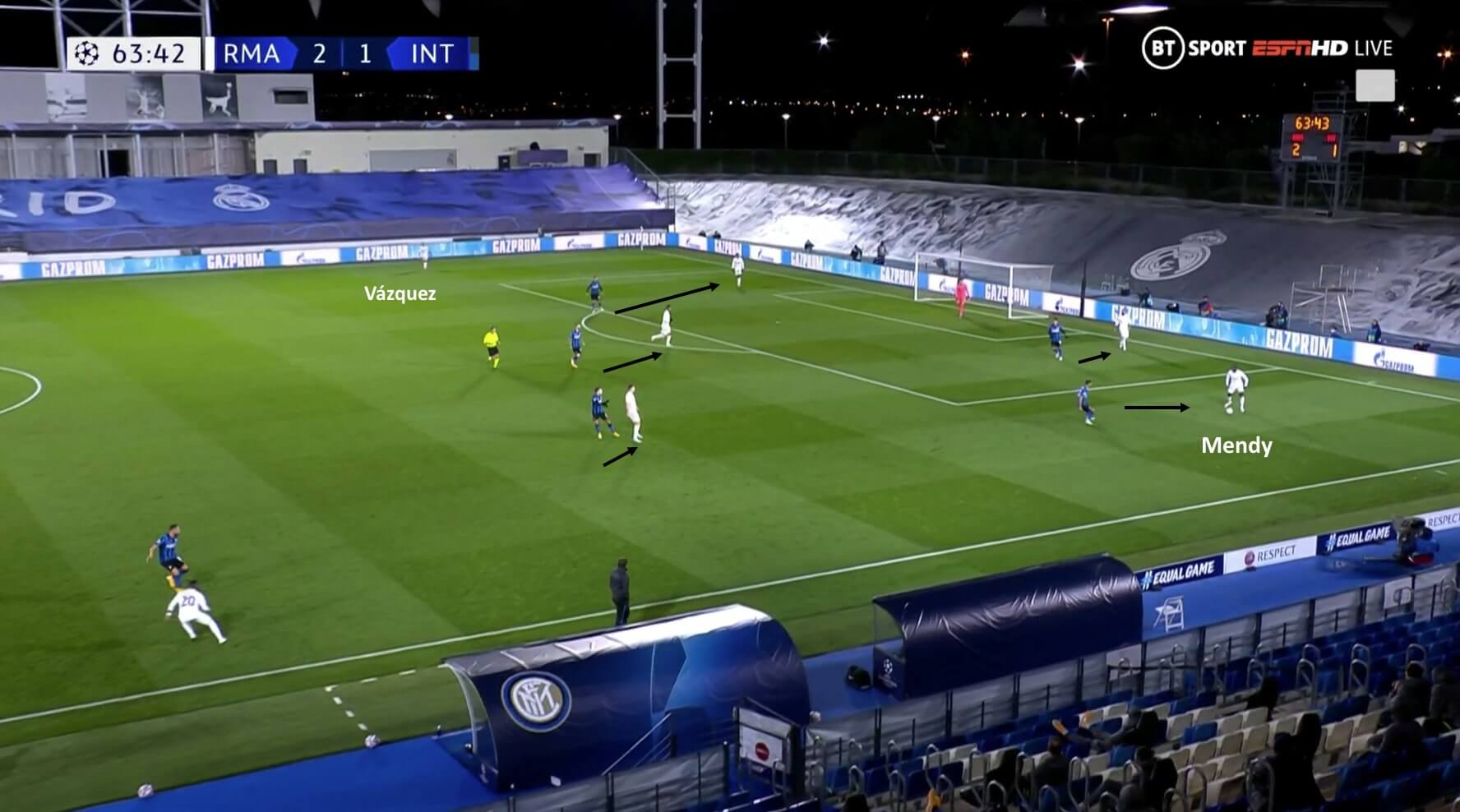
Observe how deep Mendy received the ball as Inter looked to press higher in order to pin the hosts into their own third. After inviting the press and drawing the Inter players towards the left side of the field, the full-back was able to play through the press and quickly switch the ball towards Vázquez, who had now, along with Valverde, isolated Vidal in a two-versus-one situation, as shown in the following figure.
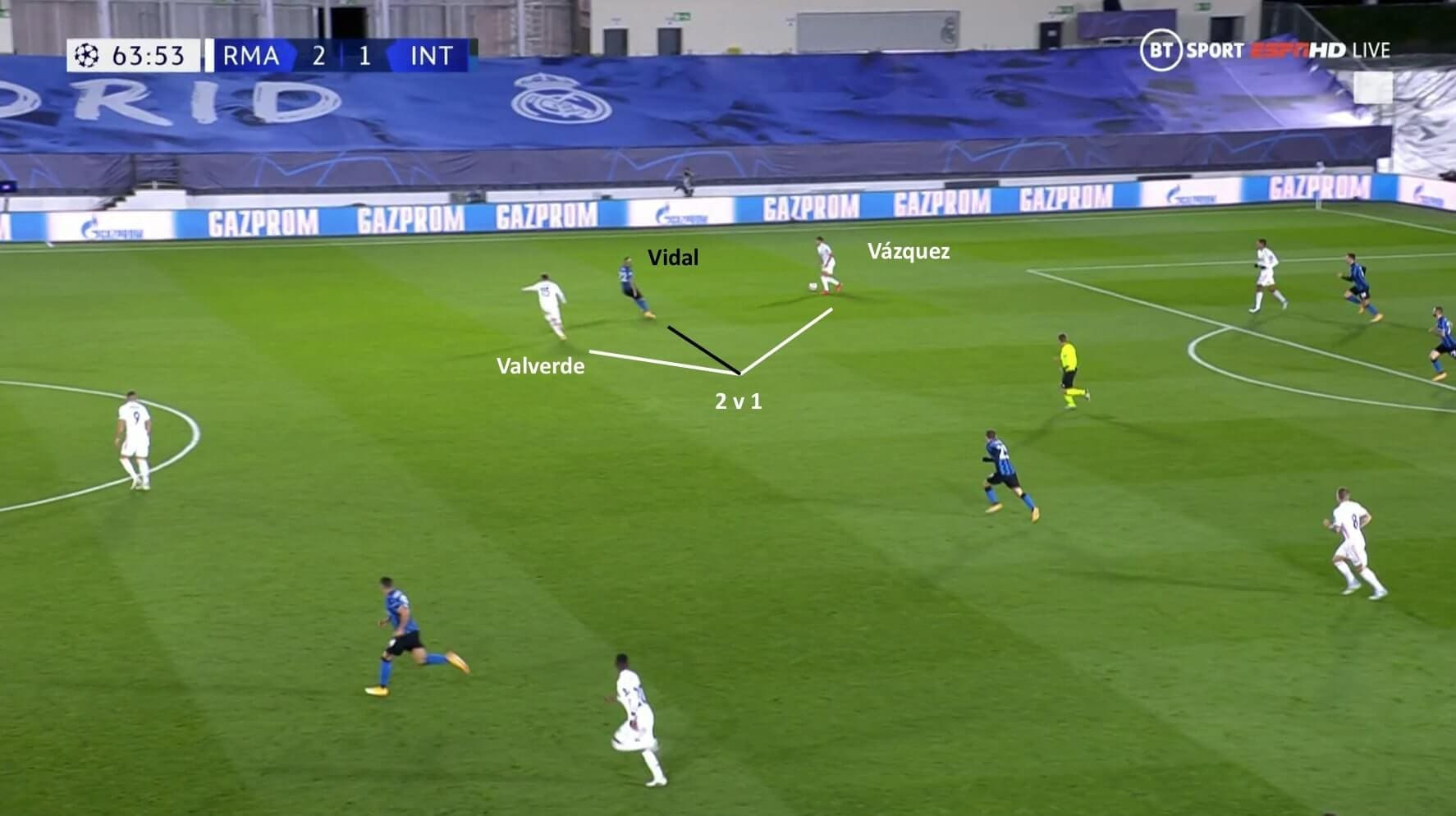
Hence, Madrid were able to smoothly manoeuvre the ball into the middle third.
The Spanish giants were quick in switching possession from the end of the field to the other in the higher thirds as well as they created several goal-scoring chances using this tactic. An instance is shown in the following couple of figures where Madrid came very close to open the scoring.
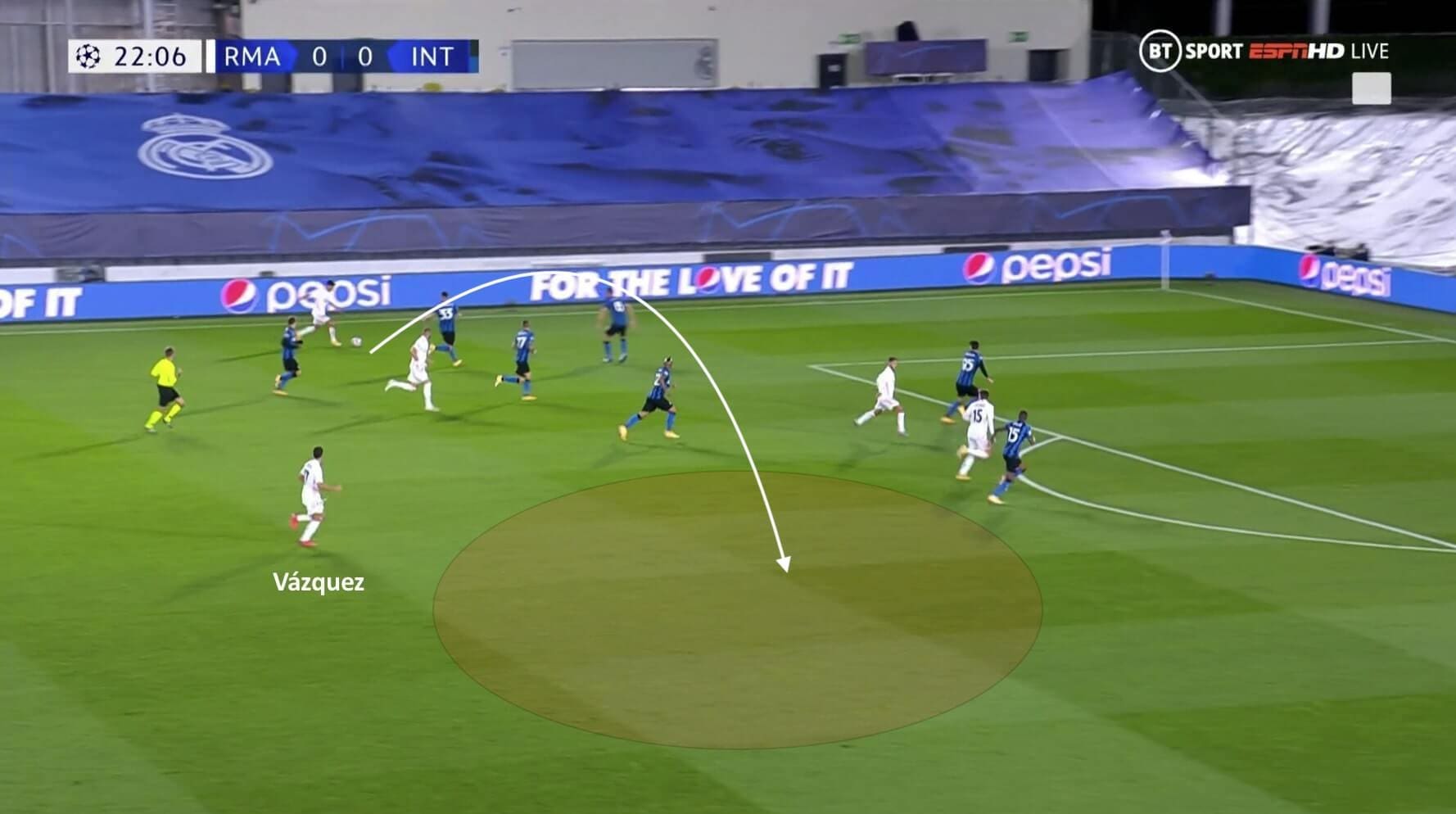
As Marco Asensio advanced into the attacking third with the ball from the left, the Inter players were drawn towards that side of the flank, in turn, creating spaces on the other side.
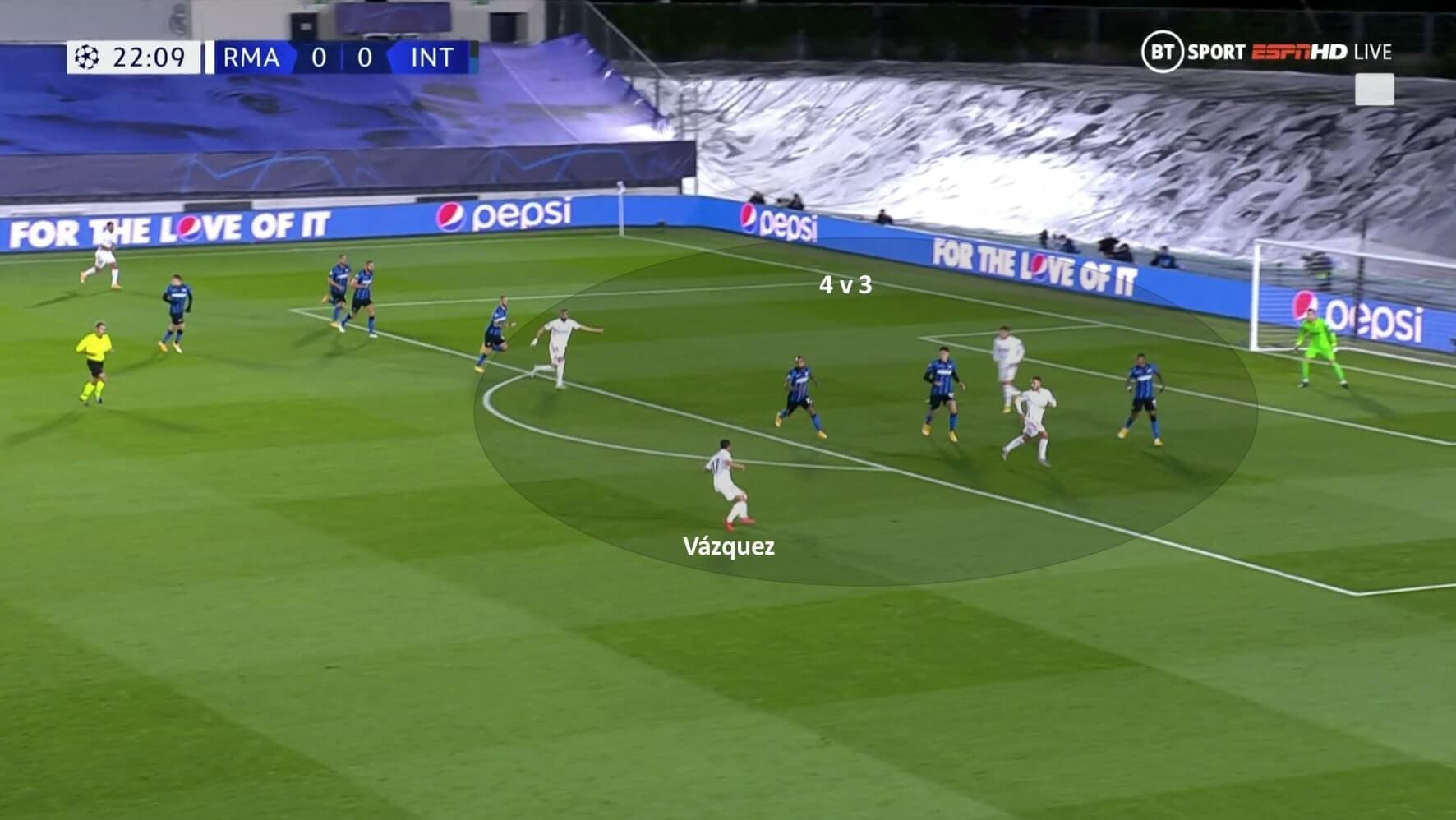
Asensio was quick to switch the play towards Vázquez, who had drifted into the right inside channel. The resulting cross allowed Madrid to have a numerical advantage in a dangerous position, as shown in the figure above. Unfortunately, Valverde had a clear shot following the attacking events after the cross which the Uruguayan missed.
We have already established that Inter looked to create most of their chances from the right. It forced Zidane to protect his left side of the field as his mid-game tactical switch ensured that Mendy stayed deeper. However, if the Frenchman was drawn out of his position during the possession, Kroos dropped deep to cover for Mendy. This allowed Madrid to formulate attacks in a 3-3-4 shape if they were able to bypass Inter’s high press, as shown in the figure below.
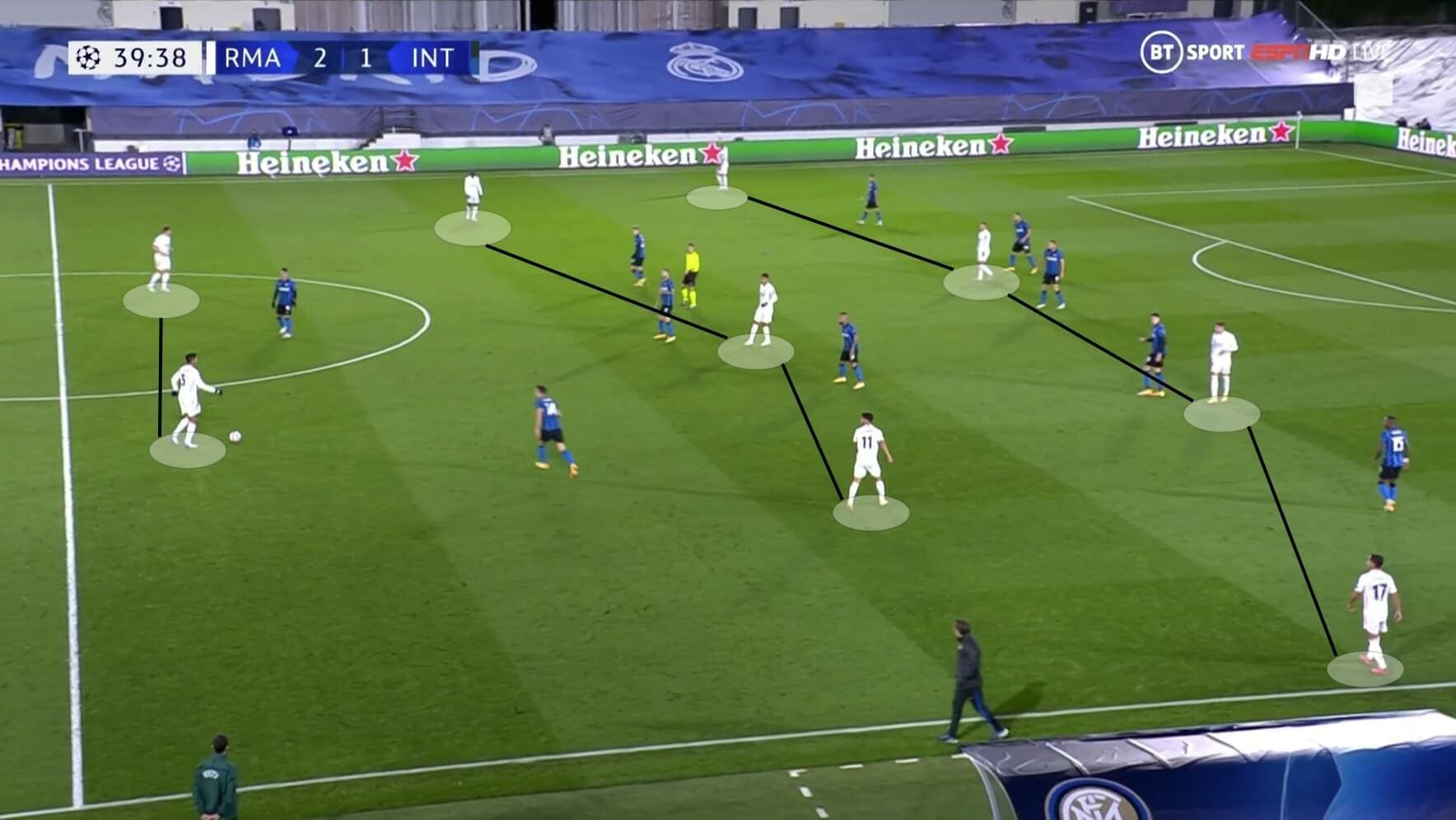
Inter switched to a mid to low 5-3-2 block in the defensive phase, as shown in the following figure. The shape was vertically and horizontally compact as it drifted laterally towards the ball.
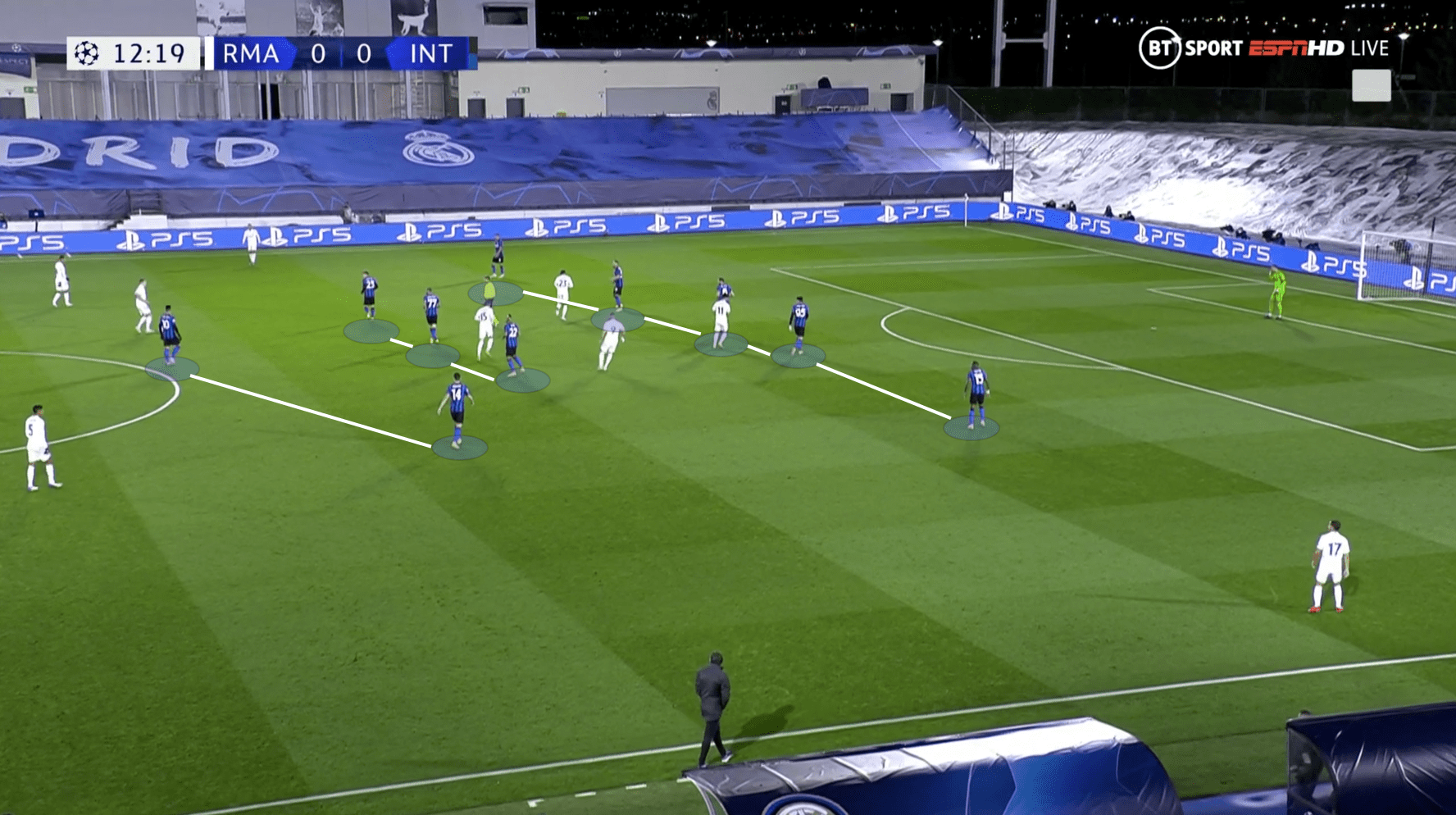
Conclusion
Overall, it was a close contest and a game where both the teams were sloppy in the final third. However, our analysis showed that Madrid deserved the win as they were better at creating goal-scoring opportunities. It is also evident from their 1.68 xG in comparison to Inter’s 1.3.
Both the teams have shown defensive frailties so far this season as they had conceded more than desired goals (Madrid 10 in eight games and Inter 12 in eight games). Hence, it was not a surprise that the game ended in a five-goal thriller. While Hakimi’s error and Ramos’ header from a Madrid corner gave them an early lead, Inter struck twice to get back into the game before Zidane’s substitutes combined to score the winning goal.
With this win, Madrid ended their four-match winless streak in the Champions League. Inter, on the other side, have distanced themselves from the rest as Conte’s men would desperately need wins in the subsequent fixtures to avoid a group stage exit yet again.





Comments